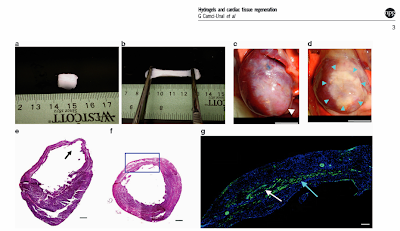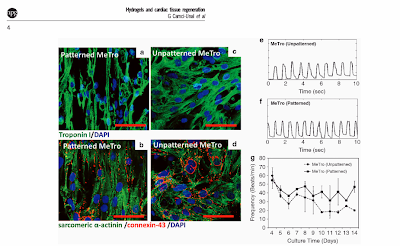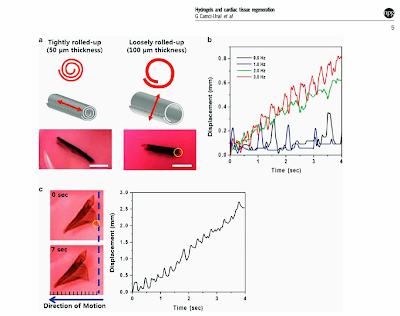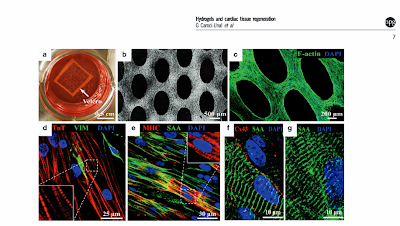The muscle tissue of the heart is remodelled following the myocardial infarction . The ventricular wall is thinning and the chamber dilates . The adult cardiomyocytes regenerate at a lower rate than the heart requires to function at the required capacity , without any treatment . The clinical strategies are to either use synthetic implants , or to deliver cells directly into the tissue . A solution to avoid their shortcomings is to use hydrophilic hydrogels as a three dimensional structure to deliver cells into the body . The review in Nature presents the hydrogels that demonstrated the ability to enhance vascularisation , or to promote the differentiation of the delivered stem cells .
The mechanical properties of the synthetic hydrogels ( Poly – ethylene glycol , Poly – N – isopropylacrylamide , Poly - 2 – hydroxyethyl methacrylate ) have the ability to control the behaviour of the cells in the damaged area of the myocardium . The NIPAAm - co - AAc - co – HEMAPTMC is a thermosensitive hydrogel that reduces the dimensions of the dilated left ventricle , while implanted in the rat with myocardial infarction . Figure 1 presents the rat myocardium eight weeks after the implantation of the hydrogel . Natural hydrogels ( Matrigel , Fibrin , hydrogel from porcine myocardial extracellular matrix ) increase the cell viability .

Figure 1 . The morphology and the experimental outcomes of the NIPAAm - co - AAc - co – HEMAPTMC thermosensitive hydrogel . ( a ) The composition of the hydrogel . ( b ) The elastic properties of the hydrogel . ( c ) The control experiment with phosphate buffered saline ( PBS ) injection . ( d ) The rat heart after hydrogel injection . ( e ) The histology analysis with hematoxylin / eosin ( H & E ) of the control experiment . ( f ) The H & E histology analysis of the rat cardiac tissue with the injected hydrogel . ( g ) Immunohistochemistry for the tissue grown into the injected hydrogel . Copyright ( 2014 ) Nature Publishing Group .
The hydrogels that demonstrate elastic behaviour while exposed to mechanical cyclic loading have the potential to repair the cardiac tissue . The hybrid of resilin – like polypeptide and Poly – ethylene glycol promotes cell differentiation after seven days of culture . The properties of Methacrylated tropoelastin ( MeTro ) are summarised in figure 2 . The micropatterned surface promotes the alignment and maturation for the cardiac cells , in the day 8 of the experiment. The frequency of the spontaneous beating rates of the cardiomyocytes was measured during two weeks of culture .

Figure 2 . The markers expressed by the primary rat cardiomyocytes . ( a ) The troponin I ( green ) and the nuclei ( blue ) on the surface patterned with The Methacrylated Tropoelastin ( MeTro ) hydrogel . ( b ) The sarcomeric &alpha - actinin ( green ) , the connexin - 43 ( red ) , and the nuclei ( blue ) on the patterned surface . ( c ) Thr troponin I ( green ) and the nuclei ( blue ) on the unpatterned surface . ( d ) The sarcomeric &alpha - actinin ( green ) , the connexin - 43 ( red ) , and the nuclei ( blue ) on the unpatterned surface . ( e ) The beating behaviour of the cardiomyocytes on the unpatterned surface . ( f ) The beating behaviour of the cardiomyocytes on the patterned surface . ( g ) Spontaneous beating rates of cardiomyocytes on the unpatterned surface . Copyright ( 2014 ) Nature Publishing Group .
The conductive hydrogels ( Chitosan , Polypyrrole ) connect areas to propagate the electrical signal into the entire cardiac tissue . The carbon nanotubes in gelatin methacrylate are actuators in the system ( figure 3 ) . The direction of motion varies as a function of the tubular thickness .
Figure 3 . The actuators were designed by incorporating carbon nanotubes ( CNTs ) in gelatin methacrylate ( GelMA) . ( a ) The tightly and the loosely rolled – up constructs were designed . ( b ) The displacement of the beating constructs are a function of frequency and electrical source . ( c ) The linear displacement of a triangular swimmer as a function of time . Copyright ( 2014 ) Nature Publishing Group .
The cardiac progenitor cells , the mesenchymal stem cells , and the pluripotent stem cells have increased potential for differentiation . The stem cell differentiation direction into the cardiac lineage is indicated by the hydrogel matrix in figure 4 . The immunostaining in the 2D hydrogels demonstrates that the sarcomere has diminished length in comparison to the one in the 3D structure .
Figure 4 . The cardiac patch was designed as cardiomyocytes derived from the human embryonic stem cells ( hESCs ) in the hydrogel matrix . ( a ) The result of 2 weeks of in vitro culture . ( b ) The gels microfacricated with elliptical pores . ( c ) The alignment of the hESCs in the hydrogel . The immunostaining on 3D hydrogel of ( d ) troponin T ( red ) , ( e ) myosin heavy chain ( red ) , ( f ) connexin - 43 ( red ) and sarcomeric α – actinin ( green ) . ( g ) The immunostaining on 2D hydrogel of sarcomeric α – actinin ( green ) . Copyright ( 2014 ) Nature Publishing Group .
The growth factors delivered with cells in the hydrogel may increase the efficiency of the process . Figure 5 presents the effect the basic Fibroblast growth factor ( bFGF ) has in a porcine model . The arteriolar density , the left ventricular ejection fraction , and the myocardial perfusion are increased at 4 weeks in culture , when the bFGF is used .
Figure 5 . The influence of the released rate of basic Fibroblast growth factor ( bFGF ) on restoring the cardiac function in a porcine model of the myocardial infarction . ( a ) The presence of the sarcomeric α – actin , ( b ) the arteriolar density , ( c ) the myocardial perfusion , and ( d ) the left ventricular ejection fraction ( LVEF ) were measured under control and the bFGF included conditions . Copyright ( 2014 ) Nature Publishing Group .
Only 10 % of the cells delivered directly in the cardiac tissue survive in vivo . The direct exposure to oxygen , free radicals , and inflammatory cytokines reduces the survival rate of the injected cells . A suitable 3D microenvironment is required . The hydrogel that mimics the cardiac tissue both handles the cyclic loading forces , and maintains the elastic , in addition to conductive , properties . The oxygen – releasing properties of a porous hydrogel , with or without the use of growth factors , increase the control of the system on the cellular environment .




